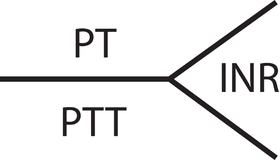Partial thromboplastin time
The partial thromboplastin time (PTT) or activated partial thromboplastin time (aPTT or APTT) is a blood test that characterizes coagulation of the blood. A historical name for this measure is the kaolin-cephalin clotting time (KCCT),[1] reflecting kaolin and cephalin as materials historically used in the test. Apart from detecting abnormalities in blood clotting,[2] partial thromboplastin time is also used to monitor the treatment effect of heparin, a widely prescribed drug that reduces blood's tendency to clot.
| Partial thromboplastin time | |
|---|---|
 Common notation of coagulation times in medical records | |
| Other names | Activated partial thromboplastin time |
| MeSH | D010314 |
Partial thromboplastin time (PTT) measures the overall speed at which blood clots by means of two consecutive series of biochemical reactions known as the intrinsic pathway and common pathway of coagulation. PTT measures the following coagulation factors: I (fibrinogen), II (prothrombin), V (proaccelerin), VIII (anti-hemophilic factor), X (Stuart–Prower factor), XI (plasma thromboplastin antecedent), and XII (Hageman factor).
The partial thromboplastin time (PTT) is often used in conjunction with another measure of how quickly blood clotting takes place called the prothrombin time (PT). The prothrombin time (PT) measures the speed of clotting by means of the extrinsic pathway.
Methodology
Partial thromboplastin time is typically analyzed by a medical technologist or a laboratory technician on an automated instrument at 37 °C (as a nominal approximation of normal human body temperature). The test is termed "partial" due to the absence of tissue factor from the reaction mixture.
- Blood is drawn into a test tube containing oxalate or citrate, molecules which act as an anticoagulant by binding the calcium in a sample. The blood is mixed, then centrifuged to separate blood cells from plasma (as partial thromboplastin time is most commonly measured using blood plasma).
- A sample of the plasma is extracted from the test tube and placed into a measuring test tube.
- Next, an excess of calcium (in a phospholipid suspension) is mixed into the plasma sample (to reverse the anticoagulant effect of the oxalate enabling the blood to clot again).
- Finally, in order to activate the intrinsic pathway of coagulation, an activator (such as silica, celite, kaolin, ellagic acid) is added, and the time the sample takes to clot is measured optically. Some laboratories use a mechanical measurement, which eliminates interferences from lipemic and icteric samples.
Interpretation
The typical reference range is between 30 seconds and 50 s (depending on laboratory). Shortening of the PTT is considered to have little clinical relevance, but some research indicates that it might increase risk of thromboembolism.[3] Normal PTT times require the presence of the following coagulation factors: I, II, V, VIII, IX, X, XI and XII. Notably, deficiencies in factors VII or XIII will not be detected with the PTT test.
Prolonged APTT may indicate:
- use of heparin (or contamination of the sample)
- antiphospholipid antibody (especially lupus anticoagulant, which paradoxically increases propensity to thrombosis)
- coagulation factor deficiency (e.g., hemophilia)
- sepsis — coagulation factor consumption
- presence of antibodies against coagulation factors (factor inhibitors)
To distinguish the above causes, mixing tests are performed, in which the patient's plasma is mixed (initially at a 50:50 dilution) with normal plasma. If the abnormality does not disappear, the sample is said to contain an "inhibitor" (either heparin, antiphospholipid antibodies or coagulation factor specific inhibitors), while if it does disappear a factor deficiency is more likely. Deficiencies of factors VIII, IX, XI and XII and rarely von Willebrand factor (if causing a low factor VIII level) may lead to a prolonged aPTT correcting on mixing studies.
History
The aPTT was first described in 1953 by researchers at the University of North Carolina at Chapel Hill explaining the Carolina blue Vacutainer tube top color.[4]
See also
References
- "KCCT - General Practice Notebook". GP Notebook. Oxbridge Solutions Ltd. Retrieved 2010-06-08.
- "MedlinePlus Medical Encyclopedia: Partial thromboplastin time (PTT)". Retrieved 2009-01-01.
- Korte, Wolfgang; Clarke, Susan; Lefkowitz, Jerry B. (January 2000). "Short activated partial thromboplastin times are related to increased thrombin generation and an increased risk for thromboembolism". American Journal of Clinical Pathology. 113 (1): 123–7. doi:10.1309/G98J-ANA9-RMNC-XLYU. PMID 10631865.
- Langdell RD, Wagner RH, Brinkhous KM (1953). "Effect of antihemophilic factor on one-stage clotting tests; a presumptive test for hemophilia and a simple one-stage antihemophilic factor assy procedure". J. Lab. Clin. Med. 41 (4): 637–47. PMID 13045017.